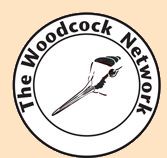The Woodcock Network

Patron ~ The Duke of Northumberland, DL, MRICS
Scientific Advisor ~ Dr Andrew Hoodless, Game & Wildlife Conservation Trust
Veterinary Advisor ~ John Chitty, BVetMed, CertZooMed, CBiol, MIBiol, MRCVS
Veterinary Advisor ~ Chris Davis, BVM&S, MRCVS
Director ~ Owen Williams
Supported by
PJE, Chartered Accountants
Website design by
Garganey Consulting
December 2009 Update
Here in West Wales we now have large numbers of woodcock on our fields at night. Up to the recent full moon in November number appeared to be about half what we would expect to see in the middle of the winter. The constant S Westerly wind and rain probably caused many birds to delay moving westwards. I noticed on my main ringing site that numbers increased through a week of wind and rain but the suddenly fell when a brief break in the weather with a moon and light Northerly breeze provided an opportunity to move on.
I hear that in some areas numbers are still lower than expected. One noticeable difference this season has been that a high proportion of adults came in on the first wave of migrants. Normally the earlier arrivals would be mainly juveniles. This has also been noticed in France by Yves Ferrand, who has a large number of active ringers, he confirms that other countries have noticed the same trend. I have recently read a research paper by a Russian biologist investigating ring returns from Russian ringed birds and they notice that juveniles migrate furthest in their first winter. He concludes that this is due to a 'hard wired' innate urge to migrate, whereas adults use previous experience to guide their movement. Another glimpse into the dynamics of this amazing bird and a good reason why we should be doing more and more ringing.
Dr Andrew Hoodless of the Game and Wildlife Conservation Trust has a number of research project on-going into woodcock. The main one being stable isotope analysis from feather samples. This has enabled him to determine places of origin of our woodcock, not a perfect tool but his PhD student, Adelle Powell from Oxford University is looking into improving accuracy with this method. So if you have feather samples please place them in individual envelopes recording place of capture and ringing details. Although they will not be able to test every one, samples from different areas of the UK will provide some valuable data.
Andrew is also looking into placing data-loggers on a number of birds later this season. These are dependant on being re-trapped the following year in order to download the daily position data but will produce some really exciting information particularly on migration destination and stop-over places and times.
With a growing number of us out there ringing woodcock we will learn a lot more about the species in the next few years. As individuals your ringing efforts and observations are making a real contribution to the knowledge base of woodcock, a species that has long been overlooked despite appearing here in winter in large numbers and going about their secretive lives in our midst.
The Woodcock Network is growing fast, we are about to register as a 'not for profit' Limited company with charitable status and we are in collaboration with the BTO, GWCT, and BASC to further our mutual aims. So far my running total on birds ringed in the UK this season stands at 161 which is well up on this time last year and suggests that we will easily beat last years total of 363 (a record for the UK). Although this should not be a competition, Tony Cross and myself stand at the top of the leaderboard with 51 and 56 respectively, This has meant a lot of dirty knees and grumpy wives having to wash smelly ringing trousers!
13-Dec-2009All content and images © 2009-2015 Owen Williams and The Woodcock Network Ltd - charitable registered company No. 7289034